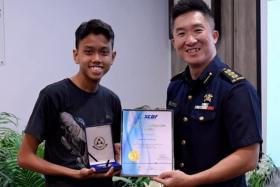Singapore, China agree on three areas for stronger cooperation
In a sign of warmer ties, Chinese Premier Li Keqiang said yesterday he has accepted Prime Minister Lee Hsien Loong's invitation to make an official visit to Singapore.
Mr Li told Deputy Prime Minister Tharman Shanmugaratnam, who conveyed the invitation, that he is looking forward to the visit, the Prime Minister's Office said, without providing a date.
Mr Tharman had called on Mr Li yesterday on the sidelines of the World Economic Forum's Summer Davos meeting in Dalian.
At their meeting, Mr Tharman also conveyed the Singapore people's and leaders' concern to those affected by Saturday's landslide in Sichuan, which left at least 15 dead and more than 100 still missing.
Mr Li thanked him for Singapore's expression of concern.
Both leaders also agreed on three specific areas where Singapore and China can cooperate more closely to take bilateral ties to the next phase.
In a sign that ties are on the mend, Mr Tharman and Mr Li agreed to deepen cooperation on the Belt and Road (B&R) initiative and push for greater economic integration of the two countries by the timely conclusion of the China-Singapore Free Trade Agreement (CSFTA) and the Regional Comprehensive Economic Partnership, a trade agreement covering 16 nations.
The two sides are also looking at ways to build Asean-China ties, such as teaming up on the training of third-country officials.
AGREEMENT
The agreement builds both on the work done when Minister for Foreign Affairs Vivian Balakrishnan met his counterpart Wang Yi a fortnight ago, and when Deputy Prime Minister Teo Chee Hean met China's Vice-Premier Zhang Gaoli in February for the annual Joint Council for Bilateral Cooperation meeting, said Mr Stanley Loh, Singapore's ambassador to China.
In particular, Singapore's participation in the B&R - China's plan to rejuvenate the ancient Silk Road trade routes linking it with much of the world - is both substantial and has much potential for further deepening, said Mr Tharman, who is also Coordinating Minister for Economic and Social Policies.
He noted in an interview with the 21st Century Business Herald newspaper yesterday that the Chongqing Connectivity Initiative - the third government-to-government project between Singapore and China - has been designated a priority demonstration project under B&R, and that the two governments signed a memorandum of understanding on B&R cooperation at its inaugural summit in Beijing last month.
The Chongqing project will link the overland Silk Road Economic Belt with the sea-based Maritime Silk Road, and it has drawn kudos from China as it will boost connectivity while helping develop its interior and Western regions.
"We can join each other's strengths, to promote the integration of the Asian region and facilitate a new phase in regional growth," said Mr Tharman, who also noted that Singapore alone accounts for 85 per cent of total inbound investments from B&R countries.
When completed, the upgraded CSFTA will include new areas such as competition, e-commerce and the environment, said Mr Tharman, while the scope of existing areas such as investment provisions, trade facilitation and remediation, and market access will likely also be widened.
FOR MORE, READ THE STRAITS TIMES TODAY
Get The New Paper on your phone with the free TNP app. Download from the Apple App Store or Google Play Store now


